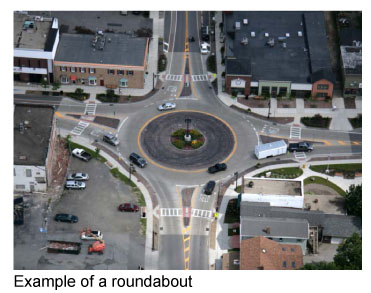
This planning tool is intended to provide consistent and systematic information regarding the issues, geometric characteristics, and traffic parameters related to a location under consideration for roundabout design. The tool is expected to assist MassDOT, MPOs, RPAs, and municipalities in screening roundabout concepts and formulating informed opinions about the appropriateness of roundabout designs, and in conveying to other interested technical staff, consultants, decision makers, and interested people the reasoning leading to these opinions.
The installation of a roundabout is beneficial only if it addresses a unique purpose for the location and if the environment is appropriate for its use. Installing a roundabout for the wrong purpose or in an inappropriate environment may lead to adverse effects. MassDOT, MPOs, RPAs, and municipalities are interested in having a consistent tool that would help in assessing whether a roundabout is a viable alternative for advancing for further analysis and design.
The following benefits will be realized from using the tool:
MassDOT staff, in the following areas—the districts, Office of Transportation Planning, Highway Design, Traffic Engineering, and Project Management—will find the tool useful. Staff will use the tool to ensure that when a roundabout concept is considered, the appropriate planning, analysis, and design aspects are well thought out early in the design process. The tool will also be useful to MPOs and RPAs, as well as to municipalities and their consultants.
This tool should be used during planning, project scoping, and preliminary engineering stages of the design process. MassDOT, the MPOs, RPAs, and municipalities can apply the tool when they:
The tool consists of general information and five steps, both sections to be completed by the user. The general information section includes fields to be filled in about the location and roadway characteristics of the intersection. The five steps are:
Step 1: Description of the existing problems
Step 2: Project objectives
Step 3: Type of roundabout and space requirements
Step 4: Roundabout screening factors
Step 5: Screening Evaluation
Information needed to use the tool includes, but is not limited to, the following:
MPOs and RPAs may be able to assist municipalities in preparing crash diagrams.
The tool consists of a series of questions that identify the opportunities a roundabout alternative may offer and the considerations to be taken into account in making a decision about whether or not to install a roundabout, and the possible impacts of a roundabout alternative at the intersection. By focusing on the existing problems, project objectives, benefits, and an evaluation of the roundabout application, the user answers the questions in the screening form to identify the feasibility and impacts of a roundabout alternative.
In the final step of the screening process, the user decides, based on the answers to the questions, whether or not the space requirements and/or the project objectives are met. The user accepts or rejects a roundabout alternative based on the following criteria:
For locations maintained by MassDOT, the MassDOT Highway Division, working in conjunction with interested parties such as MPOs, RPAs, and municipalities, will sign off on whether or not a roundabout alternative is feasible and worthy of advancing for additional analysis and design.
There are three forms of circular intersections in the United States where traffic travels counterclockwise around a central island and entering traffic must yield to circulating traffic. They are roundabouts, rotaries, and traffic circles. The design features of each form present operational and safety benefits or disadvantages. The sections below draw heavily from NCHRP Report 672, Chapter 1, and the reader is encouraged to refer to it for more information.6
Roundabouts are characterized by having smaller circular intersections than rotaries do. They operate with yield control of all entering traffic, and have channelized approaches and deflections to achieve slower entry and circulating speeds. These features of roundabouts improve safety by reducing the number and severity of crashes and allow the roundabouts to operate efficiently.

Mini-roundabouts are small roundabouts with a fully traversable central island to accommodate trucks. They are most commonly used in low-speed urban environments with average operating speeds of 30 mph or less. They can be useful in environments where a conventional roundabout design is precluded by right-of-way constraints. Because they are small, mini-roundabouts are perceived as pedestrian-friendly, with short crossing distances and very low vehicle speeds on approaches and exits.

Rotaries are sometimes called traffic circles. Rotaries are large-diameter circular intersections, usually with high entry and circulating speeds. Due to the high speeds and weaving at rotaries, maneuvers are challenging and injuries from crashes are more severe. Rotaries can be signalized or unsignalized (stop-controlled or uncontrolled), and they have different operational conditions than roundabouts.
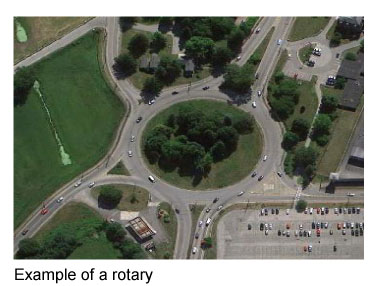
Neighborhood traffic-calming circles are much smaller than modern roundabouts and often replace stop signs at four-way intersections. They are typically used in residential neighborhoods to decrease traffic speeds and reduce accidents, but are typically not designed to accommodate large vehicles.
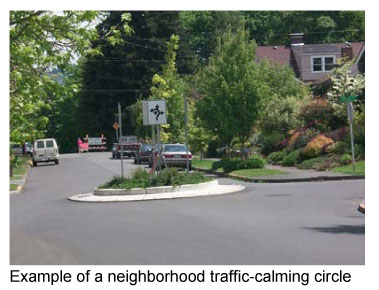
The following sections about how one should approach and drive within roundabouts and rotaries draws heavily from MassDOT’s Registry of Motor Vehicles Driver’s Manual (revised October 2012).
If the roundabout or rotary has a single lane, you must enter from the right lane of the road you are coming from. You must exit into the right lane of the road you intend to travel on. (See the first figure below, “An example of driving through a single-lane roundabout.”)
If the roundabout or rotary has multiple lanes, look for signs to help you choose the proper lane. (See the second figure below, “An example of driving through a multi-lane roundabout.”) If there are no signs, you should do the following:
In a multiple-lane roundabout or rotary, there may be traffic on both sides of your vehicle. Do not attempt to move out of your lane until it is safe to do so. If you miss your exit, don’t get upset. Check the traffic around you. If it is safe to do so, go around again and position your vehicle to properly and safely exit the rotary. Do not stop in the roundabout or rotary.
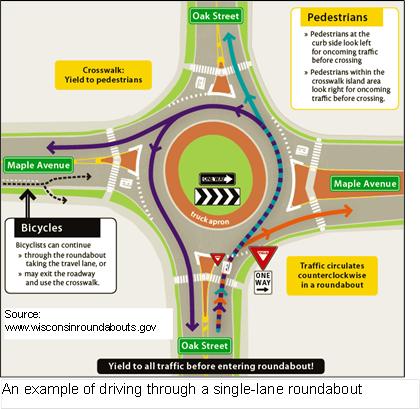
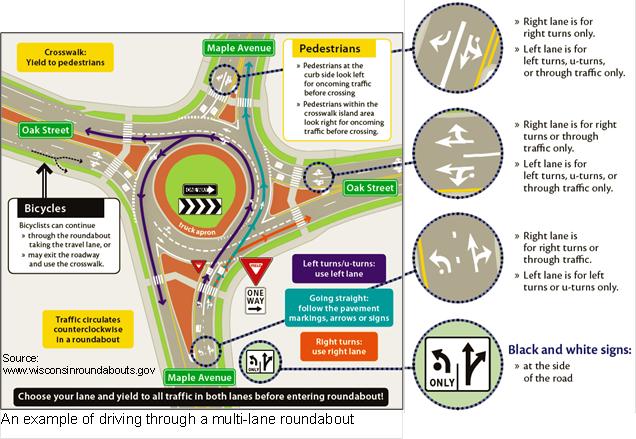
Roundabouts have a wide range of possible applications, each with its own benefits and considerations. Therefore, during the screening of roundabout alternatives for feasibility and possible recommendation for further analysis and benefits and considerations of that application need to be considered. Some of the environments where roundabouts have potential applications and the benefits and considerations associated with each application are listed below, which draw heavily from the NCHRP Report 672, Chapter 3, and the reader is encouraged to refer to it for more information.7
In residential areas, roundabouts provide traffic calming and aesthetic appeal to residents.
Benefits |
Considerations |
|
|
|
|
|
|
|
|
Roundabouts provide aesthetic and community enhancement in suburban and rural municipalities, where traffic volumes are often lower and right-of-way may not be an issue but where safety problems persist.
Benefits |
Considerations |
|
|
|
|
|
|
|
Urban centers have multimodal needs (pedestrians, bicycles, motorists, transit users, emergency vehicles, trucks, and buses), and are usually constrained, requiring U-turn and left-turn maneuvers and midblock pedestrian crossings. Roundabouts that are used in conjunction with median installations offer opportunities for improving access and mobility in urban centers.
Benefits |
Considerations |
|
|
|
|
|
|
|
|
|
|
|
Roundabouts reduce speeds and improve pedestrian crossings by providing refuge in the splitter island for pedestrians and pedestrians focusing on one traffic stream at a time, therefore they may be suitable for intersections near schools.
Benefits |
Considerations |
|
|
|
|
|
|
|
Interchanges ramp terminals with high left turn volumes and limited storage for queues are potential candidates for roundabouts. Roundabouts require less space at the approaches and on the roadway segments leading to the approaches. Hence they could prevent expensive bridge widening and reduce cost significantly.
Benefits |
Considerations |
|
|
|
|
|
|
|
|
Roundabouts have been used in traffic-calming treatments to reduce speeds and increase safety for pedestrians and roadside activities. They are also potential candidates for gateway treatments to schools and towns. In these applications, capacity and safety are not project objectives but measures should be taken to prevent creating any safety and operations problems that currently do not exist.
Benefits |
Considerations |
|
|
|
|
|
In commercial centers, roundabouts provide for a central focus point for a development and enhance aesthetic qualities.
Benefits |
Considerations |
|
|
|
|
|
|
|
Intersections with unusual geometric configurations are difficult to operate. However, the operational features of a roundabouts offer unique benefits for effectively managing traffic flows at intersections with unusual geometry.
Benefits |
Considerations |
|
|
|
|
|
Roundabouts balance traffic flows and manage queue lengths between closely spaced intersections.
Benefits |
Considerations |
|
|
|
|
Gaining public acceptance of roundabouts is a big challenge facing municipalities and agencies that plan to install roundabouts. The tool will assist MassDOT staff in screening roundabout concepts and formulating informed opinions about roundabout designs, and it will enable them to better convey to stakeholders (interested members of the public, developers, consultants, emergency departments, elected officials, and business owners) the reasoning that led to these opinions.
It is important that the public involvement process be initiated as soon as practical, preferably early in the planning stages (immediately after the roundabout screening analysis), while other intersection designs are also being considered. Therefore, the project manager must identify the stakeholders and their interests and concerns about how a roundabout is going to affect them. Equally important is how those interests and concerns are going to be addressed during the design phase.
The selection of which methods will be used to convey information to different groups of stakeholders is vital. Methods include, but not limited to, the following: public meetings, informational brochures and videos, websites, and media announcements. The effectiveness of each of these methods depends on the type of stakeholder. Because each stakeholder is affected differently, it may be prudent to use more than one method to convey information to stakeholders.
Media content is also important and should be appropriate to the type of audience that is being targeted. The content should include information and reports of experiences that may provide value for stakeholder audiences in specific situations, and it should be geared to their specific interests and concerns. For general audiences, general information about the environment, the type of roundabout, benefits and considerations, and other intersection designs may be appropriate.
Feedback garnered from the public participation process must be utilized in further design and analysis to refine alternatives and gain public acceptance. It must be emphasized that the public involvement process does not end until the project has been implemented and is operating satisfactorily.
| MASSACHUSETTS ROUNDABOUT INSTALLATION SCREENING FORM | ||||||||||||
| GENERAL INFORMATION | ||||||||||||
| Highway district: | Major street: | |||||||||||
| MPO/RPA: | Minor street: | |||||||||||
| City or Town: | Existing intersection control: | |||||||||||
| Prepared by: | Number of legs at the intersection: | |||||||||||
| Submitted by: | ADT on major road: | |||||||||||
| Reviewed by: | ADT on minor road: | |||||||||||
| Phone: | Total number of crashes (3-year average): | |||||||||||
| Email: | Speed limit (major road): | |||||||||||
| Date: | Speed limit (minor road): | |||||||||||
| RESOURCES: DATA AND INFORMATION REQUIRED FOR ASSESSMENT | ||||||||||||
| 1. Traffic counts (ADT and turning movements) | 6. Aerial photographs of location | |||||||||||
| 2. Vehicle classification (trucks and buses) | 7. Crash data (3 years) | |||||||||||
| 3. Pedestrian and bicyclist counts | 8. Crash diagrams | |||||||||||
| 4. Plan sheet or layout of existing intersection | 9. Speed data | |||||||||||
| 5. Geometric layout of roundabout | ||||||||||||
| STEP 1: BRIEF DESCRIPTION OF EXISTING PROBLEMS | ||||||||||||
| STEP 2: PROJECT OBJECTIVES (Check all that apply) | ||||||||||||
| Question Number | Objectives | Primary | Secondary | Comment | ||||||||
| Yes | No | Yes | No | |||||||||
| 2.1 | Safety improvement | |||||||||||
| 2.2 | Operational improvement | |||||||||||
| 2.3 | Traffic-calming improvement | |||||||||||
| 2.4 | Aesthetics/community enhancements | |||||||||||
| 2.5 | Access management improvement | |||||||||||
| STEP 3: TYPE OF ROUNDABOUT AND SPACE REQUIREMENTS (Check one) | ||||||||||||
| Question Number | What type of roundabout is needed? | Yes | No | Other | Comment | Considerations/Supporting Information | ||||||
| 3.1 | Mini-roundabout (Use Exhibit 1 for planning estimate of a mini-roundabount.) |
|||||||||||
| Single-lane roundabout (Use Exhibit 2 or 3 for planning estimate of a single-lane roundabout.) |
Familiar to many motorists, pedestrians, and bicyclists. Has fewer conflict points than multi-lane roundabouts. | |||||||||||
| Double-lane roundabout (Use Exhibit 2 or 3 for planning estimate of a double-lane roundabout.) |
Multi-lane roundabout is a big step from a single-lane roundabout and could pose challenges for pedestrians, bicyclists, and motorists. Consequently, a multi-lane roundabout could lead to project delays and may be a major factor in rejecting a roundabout design from further consideration in some cities and towns. | |||||||||||
| 3.2 | Space requirement Would there be sufficient right-of-way to build the roundabout? (Use Exhibit 4 for planning estimate of space requirements.) |
Right-of-way and geometric complications can be overcome in certain situations. In addition, consider cost and impact of land acquisition. | ||||||||||
| Assessment (3.1 to 3.2) |
Based on your answers above, is the space requirement met? | |||||||||||
| STEP 4: ROUNDABOUT SCREENING FACTORS (Check all that apply) | ||||||||||||
| SAFETY FACTORS | ||||||||||||
| Question Number | Does the intersection where a roundabout is being considered have safety issues: | Yes | No | Other | Comment | Considerations/Supporting Information | ||||||
| 4.1 | Resulting from multi-leg intersection or unusual geometry? | Too-tight skewed intersections can be problematic for large vehicles (design issues). In addition, too many legs could preclude using a roundabout design. | ||||||||||
| 4.2 | Resulting from high-speed crashes? | The purpose of considering a roundabout design could be to control speeds in conjunction with addressing other intersection control needs. | ||||||||||
| 4.3 | Causing crashes that are angle-type? | Roundabouts reduce the number of conflict points at which opposing vehicles intersect, hence they can provide possible solutions for angle crashes involving left-turn and crossing movements. |
||||||||||
| 4.4 | Associated with crashes resulting in personal injuries? | Collisions at roundabouts tend to be less severe because of low speeds on the entry approach and in the circulating roadway (20 - 25 mph). | ||||||||||
| Question Number | Does the intersection where a roundabout is being considered have safety issues: | Yes | No | Other | Comment | Considerations/Supporting Information | ||||||
| 4.5 | Associated with sight distance obstructions caused by alignment on existing stop-controlled approach? | |||||||||||
| 4.6 | Associated with a change-in-speed environment of the roadway? | Generally, they occur at the fringes of an urban environment. |
||||||||||
| 4.7 | Associated with visibility from all approaches? | Some types of topography and construction complications can be overcome. The Highway Division successfully addressed vertical alignment issues and steep grades of a roundabout proposal on Cape Cod. |
||||||||||
| 4.8 | Associated with pedestrian and bicyclist volumes? | This would be an issue with a multi-lane roundabout and would need for further investigation, but it is less of a concern with a single-lane roundabout. |
||||||||||
| Assessment (4-1 to 4-8) |
Based on your answers above, is the project safety improvement objective met—i.e., would a roundabout design address one or more of the project safety issues? | |||||||||||
| OPERATIONAL FACTORS | ||||||||||||
| Question Number | Does the intersection where a roundabout is being considered have issues: | Yes | No | Other | Comment | Considerations/Supporting Information | ||||||
| 4.9 | Resulting from a high percentage of left turns experiencing high delay or a need for left-turn lanes or U-turns? | Roundabouts may accommodate left-turning vehicles more efficiently with lower delays because they may not require storage lanes or separate turning phases. | ||||||||||
| 4.10 | Resulting in high delay but failing to meet traffic signal warrants? | |||||||||||
| 4.11 | Resulting from a high proportion of left turns experiencing high delay and limited storage on an off-ramp? | A roundabout design can be particularly beneficial at interchanges if the roundabout alternative does not require bridge widening. | ||||||||||
| Question Number | Is the intersection where a roundabout is being considered located: | Yes | No | Other | Comment | Considerations/Supporting Information | ||||||
| 4.12 | Where traffic volumes on the minor roads are such that STOP or YIELD signs result in unacceptably high delays for the minor road? | |||||||||||
| 4.13 | Where high traffic volumes during peak hours face excessive delays, but relatively low volumes and delays during non-peak hours? | |||||||||||
| 4.14 | Away from a signalized intersection, where queues in general will not spill back into the roundabout? | Queue detection is an example of a possible remedy if queue spillback into the roundabout is occasional. Proper signal timing and coordination may remedy some queue spillbacks. | ||||||||||
| Question Number | Is the intersection where a roundabout is being considered located: | Yes | No | Other | Comment | Considerations/Supporting Information | ||||||
| 4.15 | Away from a school drop-off/pickup area, or transit stop, where queues in general will not spill back into the roundabout? | Bus bays or pullouts or locating transit stops further downstream of the splitter island may prevent queues from blocking the roundabout. | ||||||||||
| 4.16 | Outside of a coordinated arterial signal system or proposed roundabout where it will not impede progression through a corridor? | If the quality of progression is poor, a roundabout can replace a signalized intersection and improve coordination. Also, with correct signal timing and coordination, roundabouts and traffic signals can exist on the same corridor. | ||||||||||
| 4.17 | In an area where the percentage of major street traffic volume does not exceed 90% of the total entering traffic volume and the major street traffic volume is not opposed by relatively light traffic on the minor street? | Depends on how light the traffic is on the minor approach. In addition, if traffic calming is the main focus, then high or low traffic volume should not be the deciding factor. | ||||||||||
| 4.18 | Away from a railroad grade crossing, where queuing would not impact the roundabout or grade crossing? | Depends on the frequency of railroad trips. | ||||||||||
| 4.19 | Away from a direct emergency access roadway or driveway with preemption, where a roundabout would not impede emergency services? | Depends on the frequency of emergency trips. | ||||||||||
| Assessment (4.9 to 4.19) |
Based on your answers above, is the project location favorable for roundabout installation—i.e., a roundabout design would function well and would not create additional operations problems? | |||||||||||
| TRAFFIC CALMING FACTORS | ||||||||||||
| Question Number | Does the intersection where a roundabout is being considered have issues: | Yes | No | Other | Comment | Considerations/Supporting Information | ||||||
| 4.20 | That need to be addressed by traffic-calming measures for pedestrians, bicyclists, motorists, and transit users? | Generally, roundabout designs addressing traffic calming are located on local and residential roads. |
||||||||||
| 4.21 | Resulting from changes in land-use environments or transition to a new land-use environment? | Roundabout designs addressing environment or land-use transitions are located in areas where there may be a need to signify to drivers that the character of the road and surrounding land use is changing and, therefore, they need to change their driving behavior. | ||||||||||
| Assessment (4.20 to 4.21) |
Based on your answers above, is the project traffic-calming improvement objective met—i.e., would a roundabout design address one or more of the project traffic calming issues? | |||||||||||
| AESTHETICS AND COMMUNITY ENHANCEMENT FACTOR | ||||||||||||
| Question Number | Is the proposed roundabout part of: | Yes | No | Other | Comment | Considerations/supporting information | ||||||
| 4.22 | A community enhancement or aesthetics (gateways) improvement project? | Roundabouts proposed for community enhancements and improved aesthetics should demonstrate that they would not introduce traffic problems that do not currently exist. | ||||||||||
| Assessment (4.22) |
Based on your answer above, is the project aesthetics and community enhancement objective met—i.e., would the roundabout design address aesthetics and community enhancement issues? | |||||||||||
| ACCESS MANAGEMENT FACTORS | ||||||||||||
| Question Number | Does the corridor in which a roundabout is being considered have issues: | Yes | No | Other | Comment | Considerations/supporting information | ||||||
| 4.23 | Related to a controlled-access corridor, where U-turns/left turns are desirable at an intersection to access properties on the opposite side of the road? | Corridors that are hampered with numerous driveways, especially those to businesses, can benefit from roundabouts. Roundabouts in conjunction with raised medians facilitate the use of U-turns and left turns at intersections and allow right-in-right-out movements at driveways. | ||||||||||
| 4.24 | Related to many access/egress points where left turns experience unacceptable delay turning into and out of driveways and consolidating and controlling access points (installing a raised median) are desirable objectives? | |||||||||||
| Assessment (4.23 to 4.24) |
Based on your answers above, is the project access management objective met—i.e., does the roundabout address access management issues? | |||||||||||
| STEP 5: SCREENING EVALUATION (Please circle one decision) | ||||||||||||
| Decision | Criteria | Comments | ||||||||||
| Candidate | Advance a roundabout design for further analysis and design if it meets both of these criteria: 1. Space requirements 2. One or more of the project objectives |
|||||||||||
| Conditional | Advance a roundabout design for further analysis and design under these conditions (specify): | |||||||||||
| Not recommended | A roundabout is not recommeded for further consideration if it fails to meet either of these criteria: 1. Space requirements 2. None of the project objectives |
|||||||||||
| ATTACHMENTS | ||||||||||||
| Please attach all of the data and information applied to this roundabout assessment tool to support your decision. | ||||||||||||
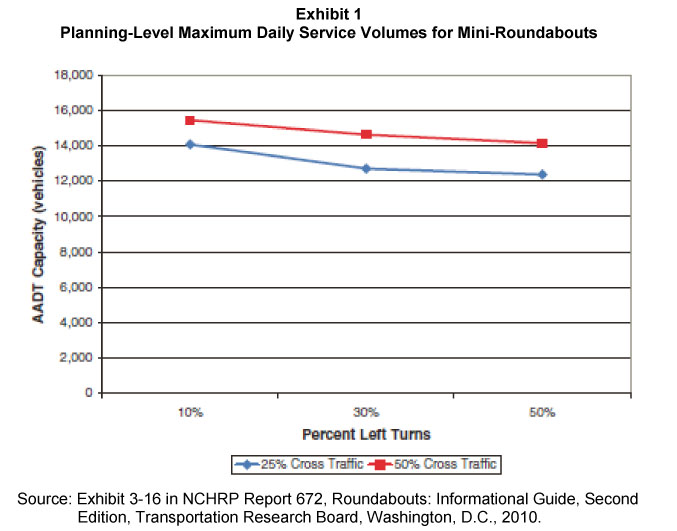
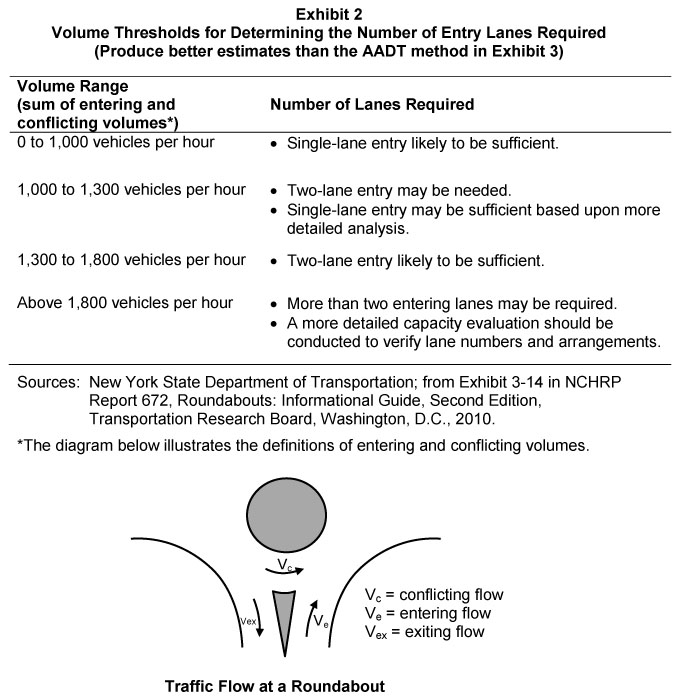
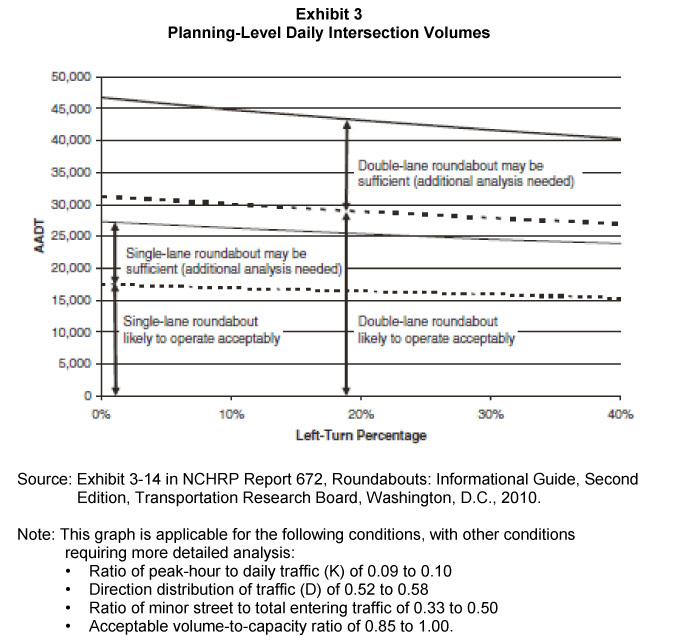

6 Transportation Research Board, National Cooperative Highway Research Program (NCHRP) Report 672: Roundabouts: An Informational Guide – Second Edition, Chapter 3, Washington, D.C., 2010.
7 Transportation Research Board, National Cooperative Highway Research Program (NCHRP) Report 672: Roundabouts: An Informational Guide – Second Edition, Chapter 3, Washington, D.C., 2010.